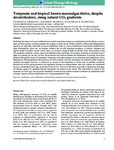Temperate and tropical brown macroalgae thrive, despite decalcification, along natural CO2 gradients
| dc.contributor.author | Johnson, VR | |
| dc.contributor.author | Russell, BD | |
| dc.contributor.author | Fabricius, KE | |
| dc.contributor.author | Brownlee, C | |
| dc.contributor.author | Hall-Spencer, Jason | |
| dc.date.accessioned | 2013-02-20T08:34:30Z | |
| dc.date.available | 2013-02-20T08:34:30Z | |
| dc.date.issued | 2012-09 | |
| dc.identifier.issn | 1354-1013 | |
| dc.identifier.issn | 1365-2486 | |
| dc.identifier.uri | http://hdl.handle.net/10026.1/1320 | |
| dc.description.abstract |
Predicting the impacts of ocean acidification on coastal ecosystems requires an understanding of the effects on macroalgae and their grazers, as these underpin the ecology of rocky shores. Whilst calcified coralline algae (Rhodophyta) appear to be especially vulnerable to ocean acidification, there is a lack of information concerning calcified brown algae (Phaeophyta), which are not obligate calcifiers but are still important producers of calcium carbonate and organic matter in shallow coastal waters. Here, we compare ecological shifts in subtidal rocky shore systems along CO2 gradients created by volcanic seeps in the Mediterranean and Papua New Guinea, focussing on abundant macroalgae and grazing sea urchins. In both the temperate and tropical systems the abundances of grazing sea urchins declined dramatically along CO2 gradients. Temperate and tropical species of the calcifying macroalgal genus Padina (Dictyoaceae, Phaeophyta) showed reductions in CaCO3 content with CO2 enrichment. In contrast to other studies of calcified macroalgae, however, we observed an increase in the abundance of Padina spp. in acidified conditions. Reduced sea urchin grazing pressure and significant increases in photosynthetic rates may explain the unexpected success of decalcified Padina spp. at elevated levels of CO2 . This is the first study to provide a comparison of ecological changes along CO2 gradients between temperate and tropical rocky shores. The similarities we found in the responses of Padina spp. and sea urchin abundance at several vent systems increases confidence in predictions of the ecological impacts of ocean acidification over a large geographical range. | |
| dc.format.extent | 2792-2803 | |
| dc.format.medium | Print-Electronic | |
| dc.language | en | |
| dc.language.iso | en | |
| dc.publisher | Wiley | |
| dc.subject | calcification | |
| dc.subject | ocean acidification | |
| dc.subject | photosynthesis | |
| dc.subject | temperate and tropical coastal ecosystems | |
| dc.title | Temperate and tropical brown macroalgae thrive, despite decalcification, along natural CO2 gradients | |
| dc.type | journal-article | |
| dc.type | Article | |
| plymouth.author-url | http://gateway.webofknowledge.com/gateway/Gateway.cgi?GWVersion=2&SrcApp=PARTNER_APP&SrcAuth=LinksAMR&KeyUT=000307222700011&DestLinkType=FullRecord&DestApp=ALL_WOS&UsrCustomerID=11bb513d99f797142bcfeffcc58ea008 | |
| plymouth.issue | 9 | |
| plymouth.volume | 18 | |
| plymouth.publication-status | Published | |
| plymouth.journal | GLOBAL CHANGE BIOLOGY | |
| dc.identifier.doi | 10.1111/j.1365-2486.2012.02716.x | |
| plymouth.organisational-group | /Plymouth | |
| plymouth.organisational-group | /Plymouth/Faculty of Science and Engineering | |
| plymouth.organisational-group | /Plymouth/Faculty of Science and Engineering/School of Biological and Marine Sciences | |
| plymouth.organisational-group | /Plymouth/PRIMaRE Publications | |
| plymouth.organisational-group | /Plymouth/REF 2021 Researchers by UoA | |
| plymouth.organisational-group | /Plymouth/REF 2021 Researchers by UoA/UoA07 Earth Systems and Environmental Sciences | |
| plymouth.organisational-group | /Plymouth/Research Groups | |
| plymouth.organisational-group | /Plymouth/Research Groups/Marine Institute | |
| plymouth.organisational-group | /Plymouth/Users by role | |
| plymouth.organisational-group | /Plymouth/Users by role/Academics | |
| dc.publisher.place | England | |
| dcterms.dateAccepted | 2012-03-31 | |
| dc.identifier.eissn | 1365-2486 | |
| dc.rights.embargoperiod | Not known | |
| rioxxterms.versionofrecord | 10.1111/j.1365-2486.2012.02716.x | |
| rioxxterms.licenseref.uri | http://www.rioxx.net/licenses/all-rights-reserved | |
| rioxxterms.type | Journal Article/Review |


